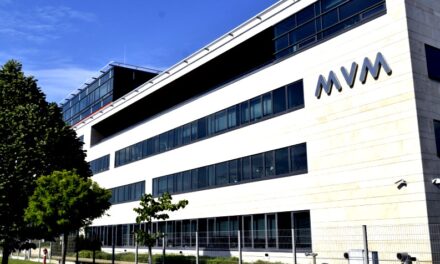Foreign film studios are mainly lured to the country by the tax incentives available in our country, so nowadays celebrities almost give each other the door handle. Currently, Ryan Reynolds and Blake Lively are in the Hungarian capital while filming the Mayday , as Angelina Jolie, Zendaya, Emma Stone and Mark Ruffalo have also visited us before.
Today, it is no surprise to anyone if you find yourself face to face with a world-famous actor - whom you only see on the cinema screen - on the streets of Budapest. Last year, for example, Johnny Depp and Angelina Jolie filmed in the Hungarian capital, but Will Smith, Russell Crowe, Rami Malek, Nicolas Cage, Eddie Redmayne and Jenna Ortega have also visited Hungary in recent years. Emma Stone, Mark Ruffalo and Zendaya also spent a lot of time with us in connection with the second part of Poor Couples and Dune, and currently Ryan Reynolds and Blake Lively are in the capital while filming the action film Mayday. The names of celebrities who have traveled to our country in the past could be listed for a long time, and the question may rightly arise as to why more and more film studios are choosing Hungary as the location for filming their various productions.
The most perfect answer to this was recently given by Jesse Eisenberg, who may be familiar from the films "Szemfenyvesztók". interview , the actor talked about the upcoming third part of the work, which will also be filmed in Budapest:
It is being made in Budapest, although we could shoot here, but Hungary lures American filmmakers there with tax incentives that I wish Poland had.
Contrary to Eisenberg's words, however, Hungary was not always so marketable. Moreover, especially in the last twenty years, it has become a Mecca for film producers, who save a lot of money, in some cases billions, by filming here.
The very first attempt to increase the international competitiveness of domestic film production was in 2004, when the relevant Hungarian film law came into force. According to this, the productions that were filmed in Hungary automatically received support. At that time, the amount of the contribution was still 25 percent, which was increased to 30 percent from June 11, 2018 - the subsidy could be claimed for all productions for which the application was submitted after this date. Filmmaking in Hungary really took off after Andy Vajná was appointed government commissioner responsible for the renewal of the national film industry in 2011, so he was responsible for developing a tax system that will attract foreign productions to Hungary. After that, the Hungarian National Film Fund was established, where funding was centralized.
The period until Andy Vajna's death, i.e. until 2019, became known as the Vajna era, when domestic film production began to move along a path that we could already be proud of - although since then something seems to have gone astray. Among other things, Vajna fought for the most favorable film subsidy system in Europe to be ours, thanks to which, since 2018, crews filming here have received a 30 percent tax refund.
As the tax consulting company Andersen explains, productions can use this support if "at least 80 percent of the direct production costs of the film production are considered direct Hungarian film production costs" . As they point out, if a work does not meet this requirement, the indirect support is based on the sum of the direct Hungarian film production costs multiplied by 1.25. The condition for applying for financing is that the company producing the given film and the production itself must be registered by the National Film Office even before production begins.
The domestic system has a big advantage
Regarding the support, it should be added that the contribution also includes a part of the salary of foreign actors and crew members who are obliged to pay taxes in Hungary. It looks like their remuneration is considered domestic expenditure up to HUF 3 million, and 50 percent above that can be accounted for in this way. However, according to the provisions of the tax treaties – which Hungary has already concluded with more than 80 countries – their income related to working in Hungary becomes taxable in Hungary in the vast majority of cases. Actors filming with us are thus obliged to pay 15 percent personal income tax on their salary and daily allowance.
As the tax consulting company draws attention to, "the inclusion of foreign actors and crew members under Hungarian taxation can mean an advantage of up to 18.75 percent for the film production, since the taxable remuneration in Hungary not only forms the basis of the 30 percent tax discount, but also increases the accountable 20 percentage base of foreign spending as well". The film production costs that can be accounted for as the basis of the subsidy include, for example, royalties (up to four percent of the production cost), the settled amount of producer fees (up to four percent of the production cost), the cost of preparation and post-production, advertising expenses (up to two percent of the production cost, but a maximum of 10 million forints), as well as travel and financing costs.
In 2024, the budget available for film productions is HUF 69 billion. Furthermore, in 2016, the motion picture professional training contribution was introduced, which is paid by film production companies receiving indirect support in an amount equal to half a percent of the production cost determined by the Film Office, but up to a maximum of HUF 15 million per production.
They save a serious amount
It is easy to get lost in the forest of preferential taxation for Hungarian film production, but thanks to the available public data, the previously mentioned can even be quantified. website of the National Film Office , there is a table titled Register of films eligible for state support and those not receiving support, in which the productions shot in Hungary since their inception, i.e. from 2012, are listed in order, explaining which company produced them, with what budget, and how much tax they were entitled to a refund.
Featured image: Gerd Altmann / Pixabay













